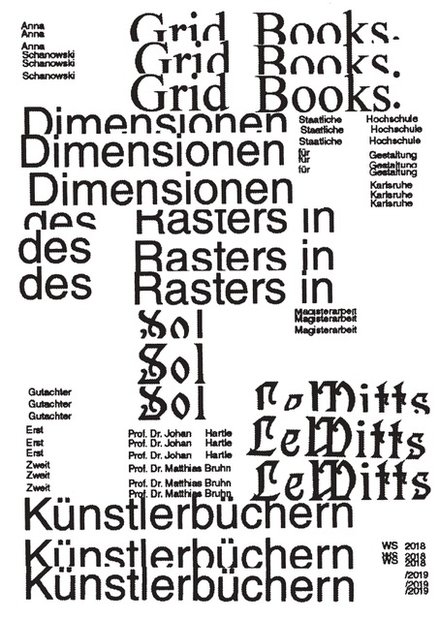

Cover (© Anna Schanowski)
In May 1980, art critic Ann-Sargent Wooster published her essay, “Sol LeWitt’s Expanding Grid” in Art in America. In it, she writes about LeWitt’s film installation for the piece, Dance (1979) and its innovative character in contrast to previous works by the American concept artist. A significant component of the stage projection shows the integrated grid structure over which the dancers move:
The presence of the grid substantially changed the appearance and the meaning of Childs’s dances […], their mathematical foundation became immediately evident. The combination of dancers and grid had exactly the opposite effect for LeWitt’s work: the figures served to humanize it.
The grid, which is not only a characteristic tool in LeWitt's oeuvre, but is also regarded as the emblematic basic structure of modernity, is suggested an unusual meaning here: through its function as a “dance floor” the reception shifts away from the original association of the abstract towards a potential subjectivity and narrativity. Finally, Wooster transfers the deconstruction of the intended reading of the grid in Dance to LeWitt's artist books: “In both his dance film and in his recent books of photographs, LeWitt has invented a way to sidestep the trap that the grid represents.” According to her assumption, the medium of the artist's book, like his cinematic work, seems to exacerbate a tension that puts the apparent stringency of conceptual strategies in a new light. Wooster's essay opens up a significant perspective on the traditional interpretation of the grid, which is also a question of great relevance for Anna Schanowski's masters work.
Together with Lucy Lippard, Sol LeWitt founded the non-profit publisher Printed Matter in 1976, which continues to act as a program distribution platform and alternative space for artists. Apart from the distributive engagement with artist books, these represent an essential means of expression of his artistic practice. In addition to the media-specific properties, such as accessibility, affordability or independence from time and place, his publications convey in particular the potential to change our perception. They are therefore representative of a conceptual examination of book artworks that reflect the content and formal language of the current context of art.
Inspired by the movement studies of photographer Eadweard Muybridge, LeWitt formulates serial classification systems in his books, in which the grid represents an underlying, structuring principle. With regard to the guiding principles of minimal and conceptual art, it becomes clear that this is not simply a formal aesthetic template, but rather implies and addresses the symptomatic discourse on the role of authorship and readership. Thus the artists and their serial work propagated, among other things, the dissolution of institutionalized hierarchies and the idealization of a self-centered artist subject. In particular, the raster structure, which actually represents a series of squares, functions here as a tool to suppress expressivity and narrativity.
However, if one looks at the development of his artists' books, the question increasingly arises as to the consequences with which the ideals of de-subjectification and non-narration are pursued and how the structure of the book relates to them. Although there are occasional literary references that address the function of the grid from a new perspective, the affirmative, generalized reception of his works is predominant in the retrospective examination of LeWitt's artist books. The double character of conceptual objectification strategies and distribution logics is mostly hidden. Based on Wooster's observations in Sol LeWitt’s Expanding Grid, Anna Schanowski uses selected publications to critically analyze the traditional function of the grid: do his systematic works fundamentally contradict subjectivity and authorship? Does the shape of the grid only serve as a design strategy for abstraction or does it also enable a narrative reception?
Tutors: Prof. Dr. Johan Hartle, Prof. Dr. Matthias Bruhn